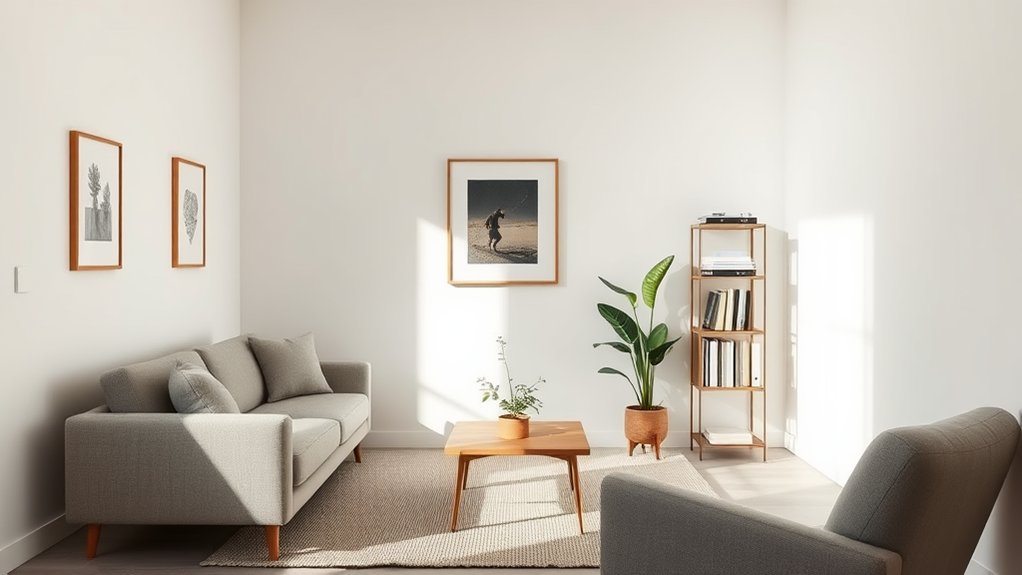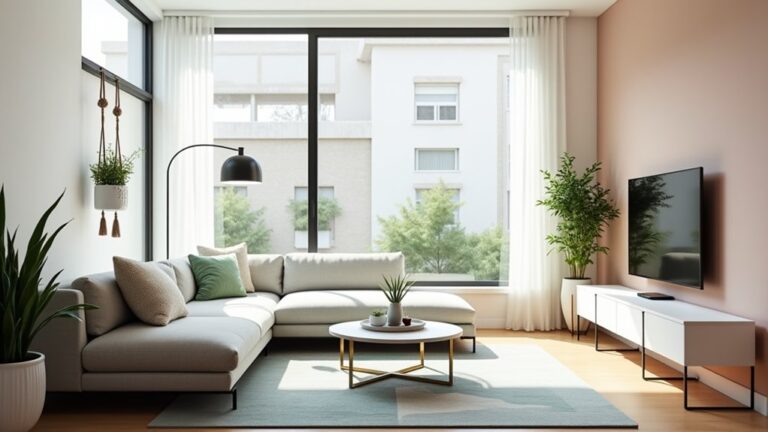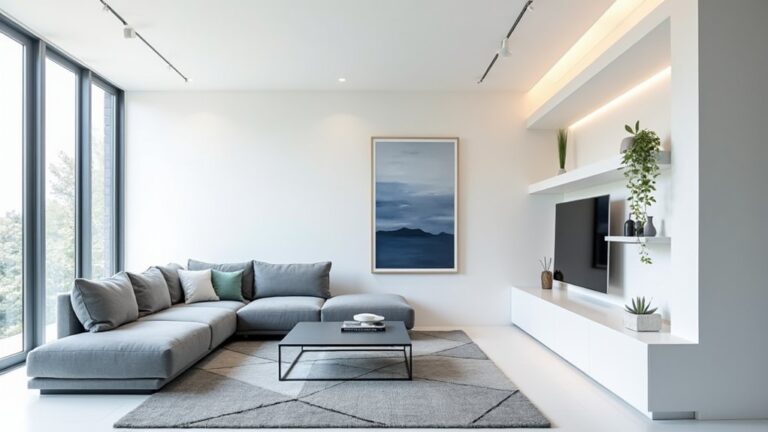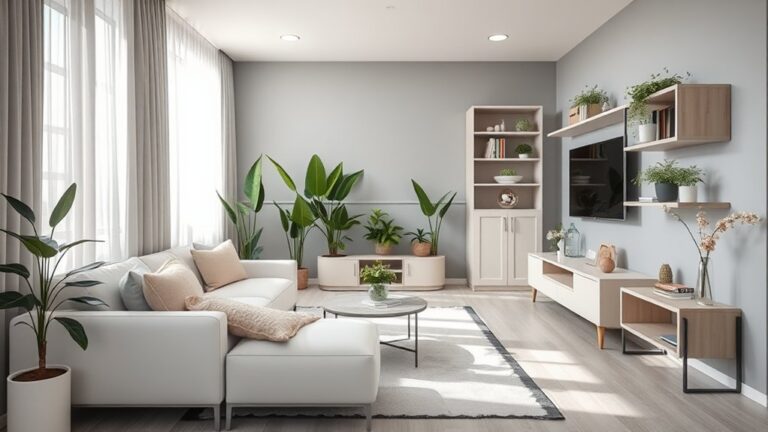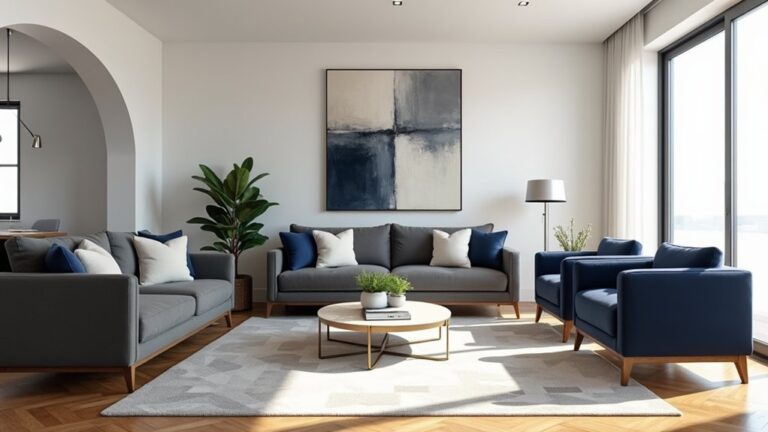The Essential Guide to Small Space Minimalism emphasizes creating a serene and functional living environment by prioritizing quality over quantity. This approach encourages intentional design choices, incorporating multifunctional furniture and neutral color palettes to enhance visual harmony. As urbanization intensifies, small space minimalism becomes vital in traversing the complexities of modern life, fostering clarity and reducing clutter. Moreover, it nurtures emotional well-being by cultivating tranquil atmospheres. By understanding the principles of minimalism and how to optimize space, individuals can transform their compact homes into organized sanctuaries. Continue exploring to discover practical tips for achieving minimalist living in your space.
Key Takeaways
- Embrace quality over quantity by selecting essential items that enhance functionality and promote a simplified lifestyle in small spaces.
- Utilize multifunctional furniture to maximize space efficiency and reduce clutter, promoting a streamlined and cohesive aesthetic.
- Opt for neutral color palettes to create a calming atmosphere while enhancing light reflection and visual openness.
- Implement clever storage solutions, like shelves and hidden compartments, to maintain organization and prevent clutter accumulation.
- Recognize the importance of negative space to create an airy feel and highlight key design features in small environments.
Understanding Minimalism
At its core, minimalism embodies a profound simplicity that transcends mere aesthetics, inviting individuals to reassess their relationship with material possessions.
Embracing minimalist living, particularly in small spaces, encourages a deliberate selection of items that truly enhance life rather than clutter it.
This lifestyle shift not only fosters a sense of tranquility but also optimizes functionality, making small environments feel expansive.
Minimalism advocates for quality over quantity, urging individuals to prioritize experiences and meaningful interactions over the accumulation of goods.
As urbanization intensifies, small space minimalism becomes increasingly relevant, guiding individuals towards smarter, more sustainable living choices.
Hence, understanding minimalism is essential for those seeking clarity and purpose in their everyday lives while traversing the complexities of modern existence.
Benefits of Minimalism
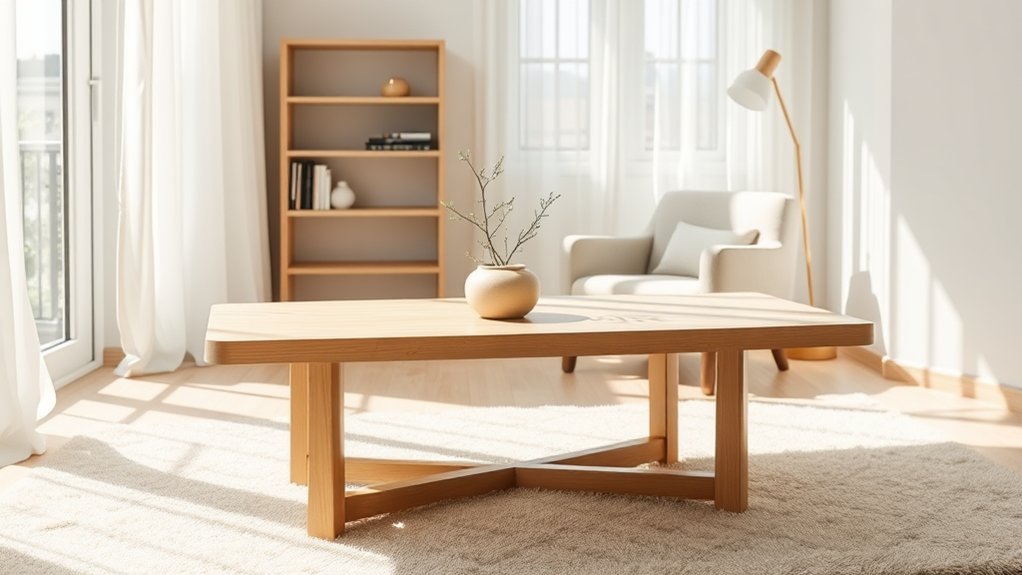
Embracing minimalism frees a myriad of benefits that extend beyond aesthetic appeal, substantially impacting mental and emotional well-being. Minimalist small space living cultivates a serene environment by reducing visual stress and distraction, enabling enhanced relaxation and focus.
The simplicity inherent in minimalist homes can lead to improved mental health, creating an atmosphere of tranquility and spaciousness that fosters clarity. Additionally, minimalist living encourages sustainability, as it often involves selecting high-quality, essential items over excessive possessions.
With a limited color palette and uncomplicated patterns, minimalist spaces are designed to increase productivity and efficiency, facilitating better time management and organization. Ultimately, the benefits of minimalism serve to uplift both lifestyle and mindset in today’s fast-paced world.
Characteristics of Minimalist Spaces
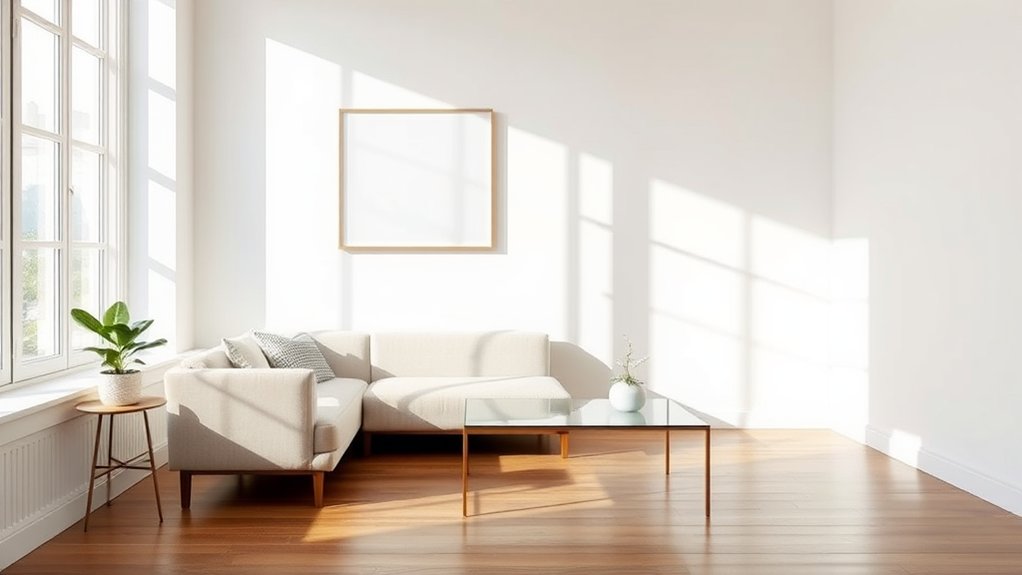
Minimalist spaces are defined by their intentional design choices, primarily revolving around simple furniture selection that emphasizes functionality and aesthetic coherence.
Clear surfaces play a critical role, promoting a sense of openness and tranquility while minimizing visual clutter.
These characteristics not only enhance the livability of small spaces but also reflect a broader lifestyle choice centered on moderation and clarity.
Simple Furniture Selection
Choosing simple furniture is essential for cultivating a serene and uncluttered environment in a minimalist space.
Prioritizing multifunctional furniture not only optimizes limited areas but also eliminates excess items, promoting a streamlined aesthetic.
Pieces that serve more than one purpose—such as a coffee table that doubles as storage—enhance practicality without sacrificing style.
In addition, adhering to a neutral color palette creates a cohesive look, allowing for easy integration into various design schemes.
Shades of white, beige, and gray foster a calm atmosphere, making small spaces feel larger and more inviting.
Ultimately, selecting furniture that harmonizes with the principles of minimalism—simplicity, functionality, and tranquility—can transform any small area into a stylish sanctuary.
Clear Surfaces Importance
The essence of a minimalist space lies in its clarity, where clear surfaces play a pivotal role in achieving visual serenity and openness.
In minimalist spaces, clear surfaces such as countertops and tables are essential for reducing visual clutter, creating a calming atmosphere.
By removing unnecessary items and utilizing storage solutions, these surfaces enhance the perception of space, making smaller areas feel larger and more inviting.
Maintaining clear surfaces requires establishing habits of regular tidying and organization, ensuring every item has a designated place.
Ultimately, this practice cultivates a peaceful, distraction-free environment that fosters focus, productivity, and relaxation, embodying the fundamental principles of minimalist design and promoting a harmonious living experience.
Principles of Minimalist Design
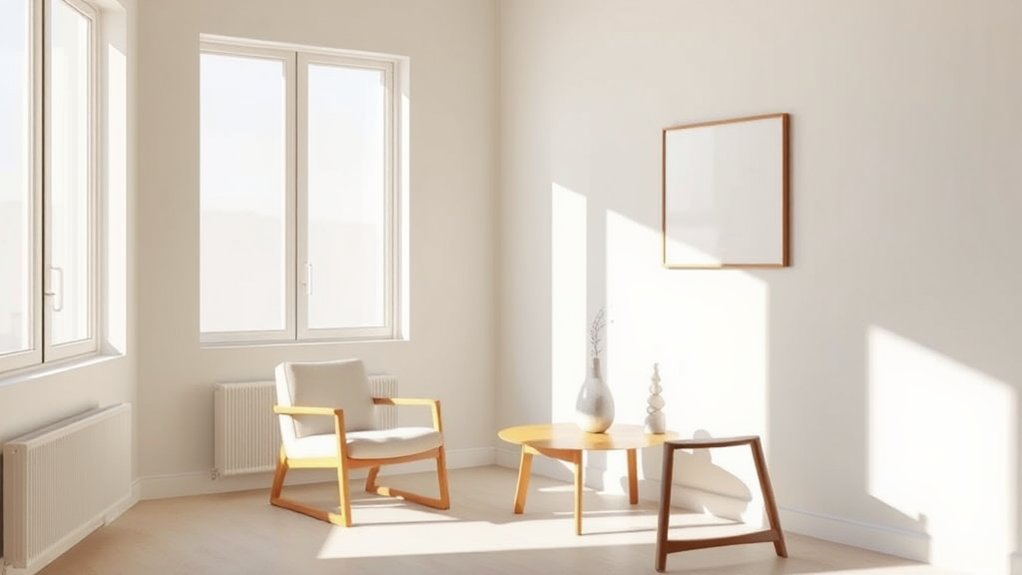
Minimalist design is anchored in the principles of clean lines and shapes, which create an unobtrusive visual flow essential in small spaces.
Complementing this aesthetic are neutral color palettes that enhance light reflection and promote a sense of openness.
Together, these elements not only elevate the style of a space but also underscore functionality and serenity.
Clean Lines and Shapes
Emphasizing clean lines and shapes is essential in achieving a minimalist design that exudes sophistication and tranquility. The minimalist aesthetic relies heavily on the beauty of simplicity; thus, the integration of geometric forms and uncluttered silhouettes becomes paramount.
This approach enhances visual clarity while drawing attention to functional elements within the space. By utilizing a restrained palette of shapes, designers can create harmony and balance, reducing visual noise that often accompanies more ornate styles. Incorporating clean lines promotes a sense of spaciousness, making even the smallest areas feel larger and more inviting.
This principle not only contributes to a serene living environment but also elevates the overall design, ensuring each piece serves a purpose while enhancing the aesthetic allure of the space.
Neutral Color Palettes
Choosing a neutral color palette is a fundamental principle of minimalist design, greatly influencing the ambiance and perception of space. Neutral tones, such as whites, beiges, and soft grays, create a calming backdrop that enhances the sense of openness in small living environments.
By opting for these understated hues, homeowners can elevate their interiors while allowing natural light to dance throughout the area, making it feel more expansive. Additionally, neutral color schemes encourage versatility, enabling the easy incorporation of varying textures and materials without overwhelming the design.
This intentional simplicity not only fosters a serene atmosphere but also provides a timeless elegance, ensuring the space remains trendy and cohesive across evolving decor trends.
Selecting Minimalist Furniture
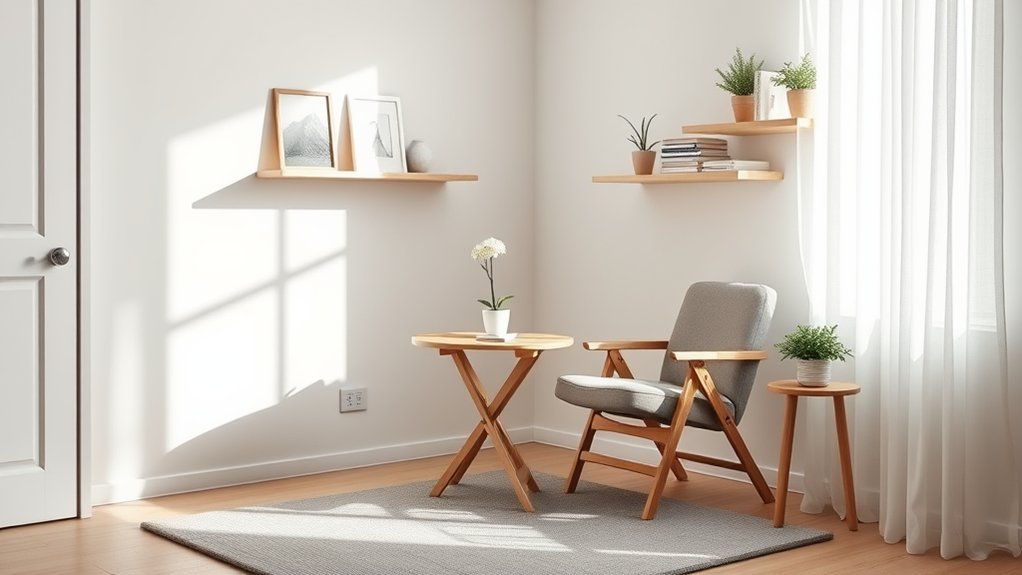
Selecting the right furniture can substantially enhance the functionality and aesthetic of small spaces. Prioritize minimalist design by choosing pieces with simple shapes and clean lines, such as a sleek sofa or a low-profile coffee table. This approach creates a sense of openness and calmness.
Multifunctional furniture, like storage ottomans or desks with built-in shelves, maximizes space efficiency and reduces clutter. Consider the scale and proportion of each piece, opting for smaller-scale or low-profile options to promote a visual flow. Furniture crafted from natural materials, like wood and glass, further maintains a cohesive look. Additionally, items featuring hidden storage or minimalist details, such as a geometric console table, guarantee a clutter-free and organized environment, essential in small space living.
Color Palette in Minimalism

In small space minimalism, color choices play a vital role in enhancing serenity and visual harmony.
A carefully curated palette of neutral tones fosters a calm atmosphere, while the strategic use of accents and variations invites depth without overwhelming the senses.
Neutral Color Choices
When it comes to minimalist design, a neutral color palette serves as the foundation for creating an ambiance of tranquility and openness in small spaces. Typically featuring shades like eggshell, cream, and light grey, these colors reflect light, making rooms appear larger while minimizing visual clutter.
Incorporating light-colored woods, such as birch or oak in furnishings, adds warmth without disrupting the serene color scheme. Employing a limited color palette of two to three main colors fosters visual coherence, enhancing the minimalist aesthetic. Monochromatic schemes, utilizing various shades of a single color, introduce depth and sophistication while maintaining simplicity.
Ultimately, neutral color choices reinforce the principles of calmness and clarity central to successful small space design.
Creating Visual Harmony
Achieving visual harmony in minimalism relies heavily on a thoughtfully curated color palette. A minimalist interior design typically employs a limited selection of 2-3 main colors, often centered around neutral shades like white, grey, and beige to evoke calmness.
The 60-30-10 rule effectively balances dominant, secondary, and accent colors, enhancing visual interest while maintaining simplicity. Incorporating soft, muted tones such as light blue or mint green can introduce warmth, complementing the natural light that brightens small spaces. Alternatively, a single, bold accent color can inject energy, provided it is used sparingly to preserve serenity.
This intentional approach to color fosters an environment that reflects tranquility and cohesion, essential for achieving true minimalism.
Space Optimization Techniques
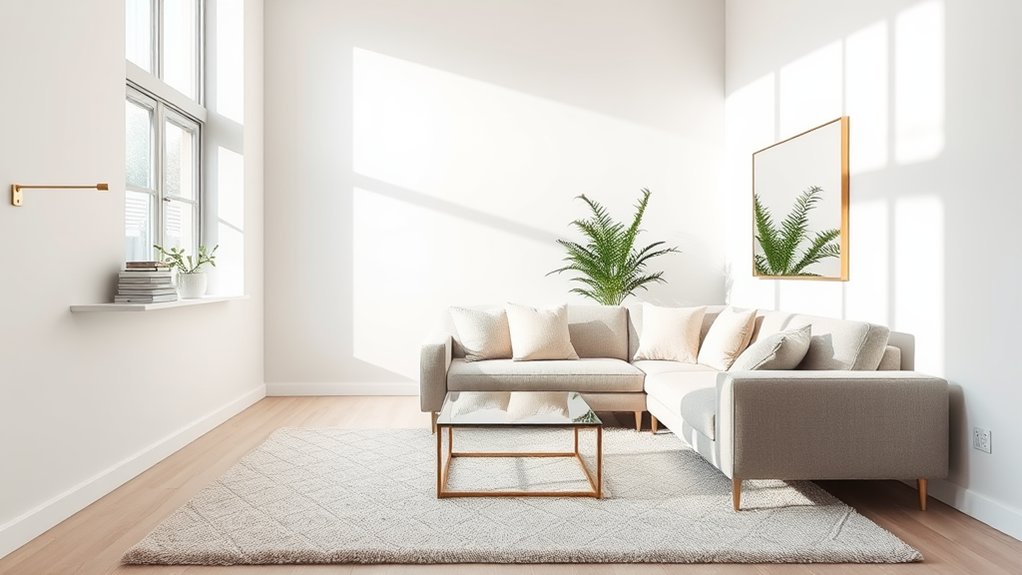
Effective space optimization techniques are essential for maximizing the functionality of small living areas. Utilizing multifunctional furniture, such as storage ottomans and beds with built-in drawers, transforms everyday items into efficient storage solutions.
Installing shelves and hooks that extend to the ceiling allows you to leverage vertical space, keeping floors clear and visually expanding the room. Adopting a “one in, one out” policy prevents clutter accumulation, ensuring a balanced living environment. Moreover, hidden storage compartments, like under-bed bins and closet organizers, conceal belongings, reducing visual clutter.
Finally, measuring your space and planning a storage system prior to furniture purchases guarantees ideal use of space, making it easier to maintain a clutter-free oasis in your small home.
Functionality in Small Spaces
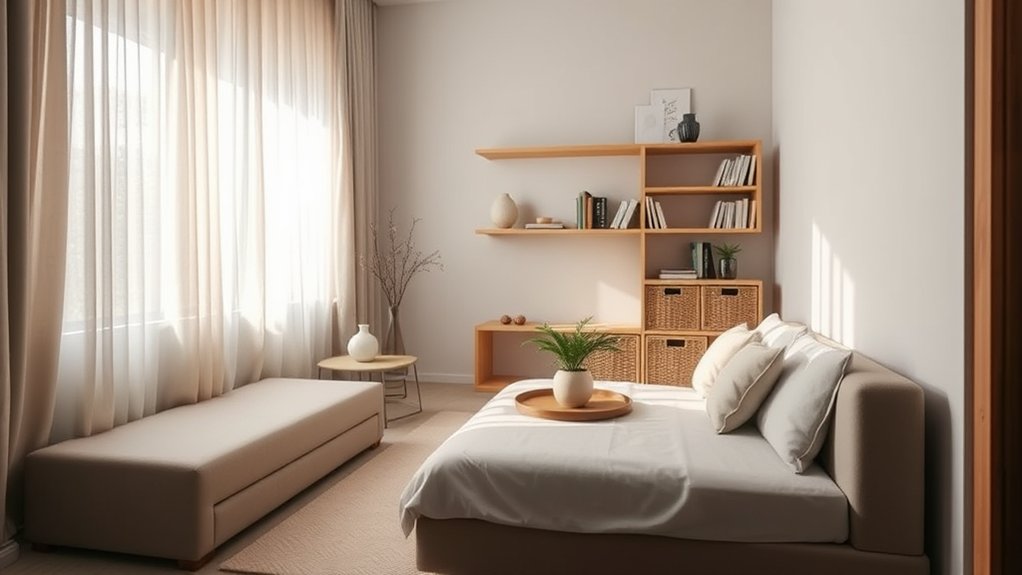
Maximizing functionality in small spaces requires a strategic approach that prioritizes versatility and smart design. Integrating multipurpose furniture, such as storage ottomans and sleeper sofas, is essential for efficient space management.
To combat clutter, vertical storage solutions like wall-mounted shelves and organizers help keep essentials accessible while freeing floor space. Customizable options for corners and narrow areas further enhance storage potential, ensuring no space goes to waste. Compact and foldable furniture, including Murphy desks and wall-mounted tables, is also invaluable for creating a more spacious environment when not in use.
Additionally, incorporating hidden storage compartments—such as under-bed bins and closet organizers—promotes a sense of openness and maintains an organized ambiance, essential for small space minimalism.
Importance of Negative Space
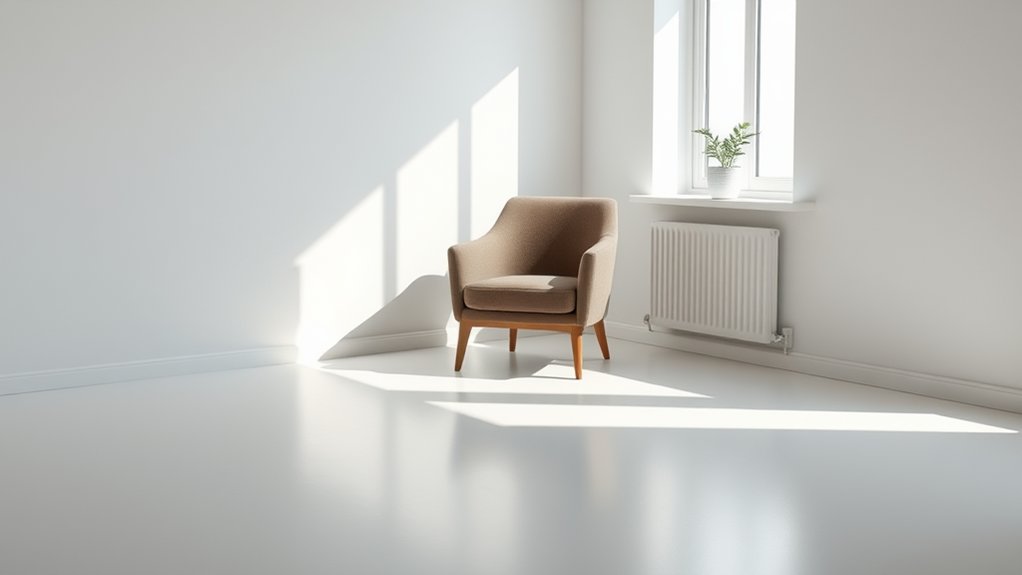
Negative space is a vital component of small space minimalism, serving as the invisible framework that enhances the overall aesthetic and functionality of a room.
By incorporating visual breathing room, we can transform compact environments, creating a perception of spaciousness that calms the mind and elevates the design.
Understanding and defining negative space empowers designers and homeowners to highlight key features, leading to harmonious and inviting living areas.
Defining Negative Space
While often overlooked, the concept of negative space plays a crucial role in the design of small minimalist environments.
This balance of empty space cultivates a minimal aesthetic, seamlessly enhancing the perception of spaciousness.
Negative space allows the eye to navigate freely, creating an atmosphere of calmness and visual equilibrium.
To effectively incorporate this principle, aim to leave 10-20% of your room’s surface area untouched, ensuring floors, walls, and counters remain uncluttered.
Utilizing furniture with exposed legs or frames fosters an airy feel while strategically highlighting design elements, such as artwork or exquisite furniture.
Ultimately, embracing negative space is essential for crafting inviting, functional spaces that prioritize simplicity and elegance.
Visual Breathing Room
Creating visual breathing room is essential in small spaces, where every inch counts. In a minimalist home, the strategic use of negative space can transform a cluttered environment into a calming oasis.
By intentionally leaving areas unadorned, you foster a sense of spaciousness that enhances both comfort and functionality. This approach not only reduces visual noise but also magnifies the impact of carefully chosen decor, introducing compelling visual interest without overwhelming the senses.
Selecting a few standout pieces while embracing simplicity allows for a harmonious balance between form and function. Ultimately, harnessing negative space encourages a tranquil ambiance, making small spaces feel larger and more inviting, perfectly aligning with the principles of contemporary minimalism.
Enhancing Room Perception
The role of negative space extends beyond merely beautifying a small room; it substantially influences how we perceive the environment around us.
By strategically utilizing negative space, designers can create the illusion of expanded areas, allowing for a more inviting and airy atmosphere.
This technique emphasizes the importance of selective arrangement and minimalist decor, enabling each element to breathe and stand out.
Incorporating negative space fosters a sense of tranquility while reducing visual clutter, essential for enhancing room perception in compact living areas.
Furthermore, well-calibrated negative space promotes functionality without sacrificing aesthetics, presenting a seamless blend of practicality and style.
Ultimately, embracing negative space leads to environments that feel both spacious and sophisticated.
Choosing Effective Lighting
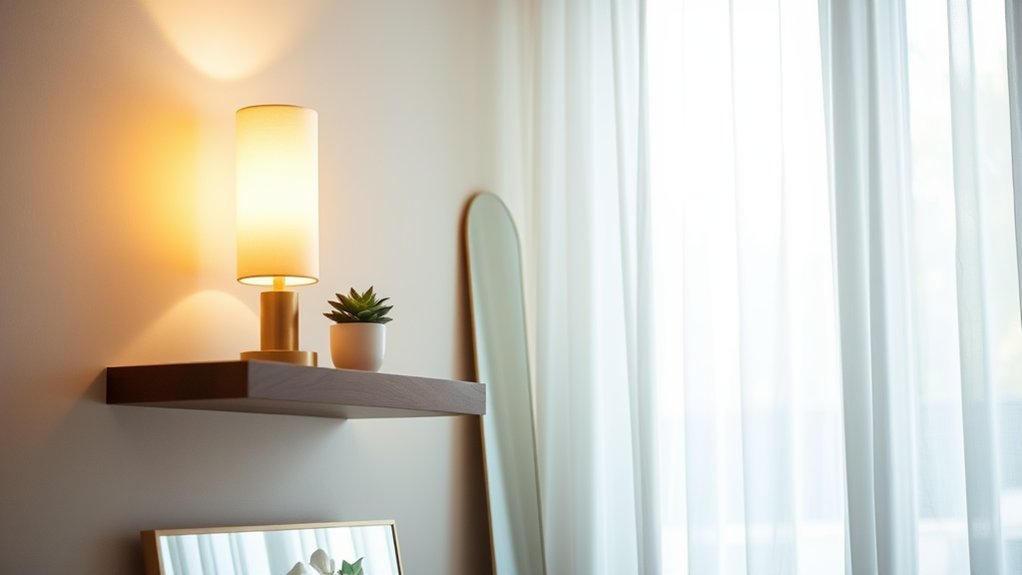
Effective lighting is a crucial element in small space minimalism, as it can dramatically influence both the ambiance and perceived size of a room. Emphasizing minimalist aesthetics, choose lighting fixtures that are sleek, unobtrusive, and enhance rather than clutter the space.
Recessed lighting and wall sconces provide a clean look while maximizing floor area, creating an open feel. Moreover, consider the strategic use of warmth and brightness; softer, warm lights can create an inviting atmosphere, whereas brighter, cooler tones can emphasize cleanliness and modernity. Pay attention to natural light sources and use sheer curtains to invite sunlight.
Ultimately, effective lighting not only elevates design but also transforms small areas into versatile living spaces, highlighting the essence of minimalism.
Utilizing Mirrors for Depth
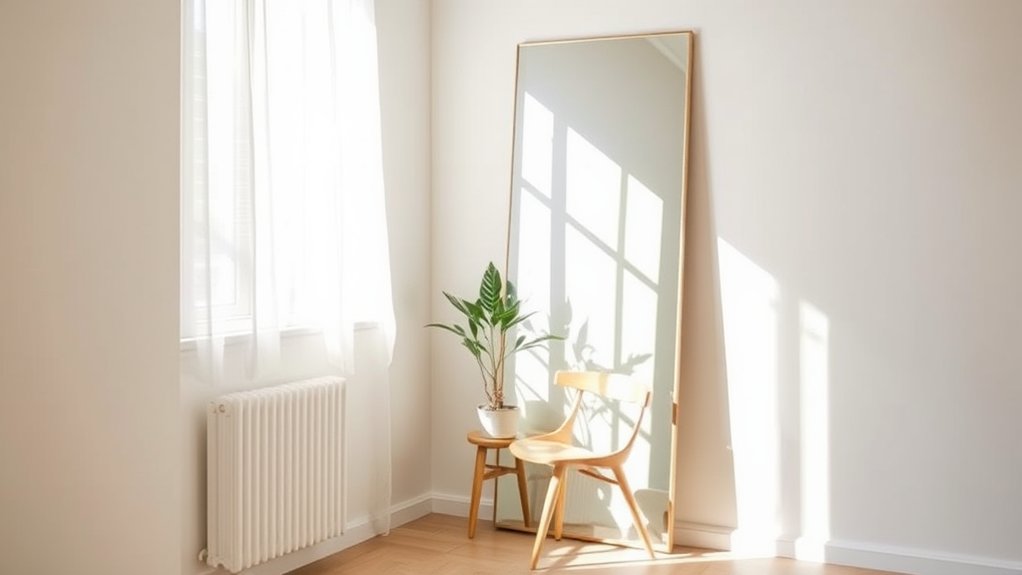
A well-placed mirror can transform the perception of space within a small room, enhancing depth and openness. Strategic placements, such as opposite windows or on adjacent walls, allow mirrors to reflect natural light, creating an illusion of increased space.
Whether utilizing standalone mirrors, wall-hung varieties, or those on sliding closet doors, these decor elements effectively contribute to visual interest while making small rooms appear lighter and more expansive. Additionally, mirrors can create a sense of continuity between rooms, particularly when positioned in doorways or hallways, fostering a more connected ambiance.
To optimize their impact, careful consideration of the size, shape, and placement of mirrors is essential—ensuring a cohesive and visually appealing atmosphere in your small space.
Multi-Functional Furniture Ideas
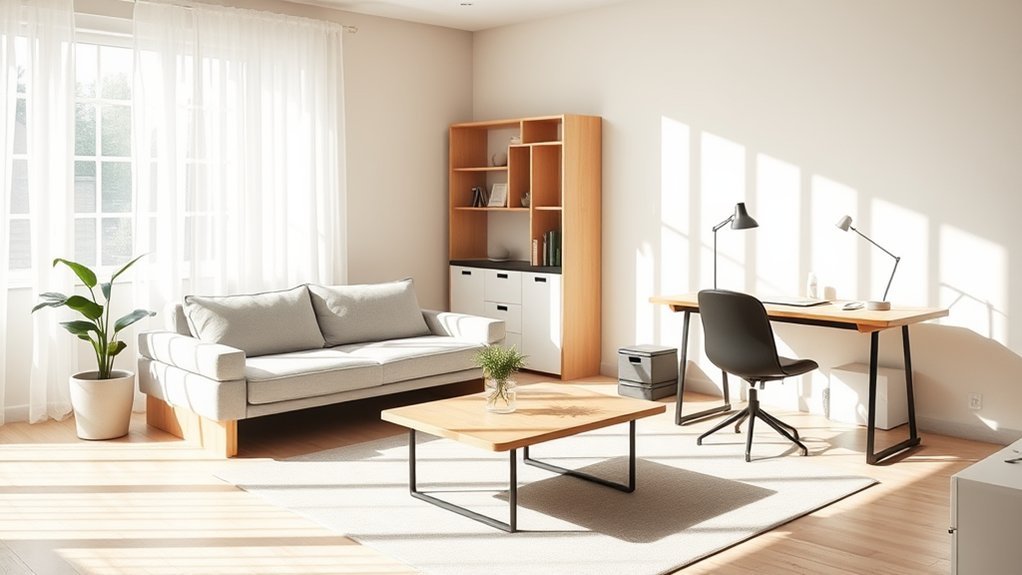
In today’s world of compact living, smartly designed multi-functional furniture has emerged as a cornerstone of small space minimalism.
Options such as storage ottomans illustrate the ideal functionality by serving as seats, footrests, and discreet storage solutions.
Murphy beds paired with desks optimize living areas, seamlessly combining sleep and workspaces to minimize clutter.
Similarly, sofa beds equipped with built-in storage offer a practical dual-purpose solution for small living rooms.
A desk with hutches not only functions as a workspace but also provides essential storage and display capabilities.
Moreover, a minimalistic coffee table designed with storage bins or shelves promotes organization while serving as a functional surface for socializing, working, or relaxing, embodying the flexibility essential to modern living.
Storage Solutions for Clutter
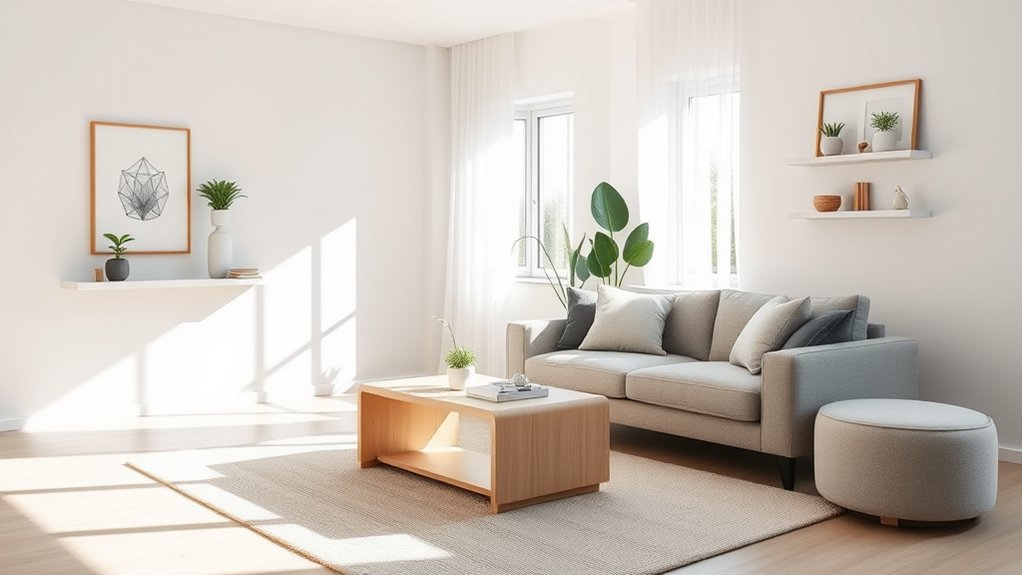
Amid the challenges of small living spaces, thoughtful storage solutions are essential for maintaining an organized and clutter-free environment.
Embracing smart storage solutions, such as multifunctional furniture like storage ottomans and beds with built-in drawers, maximizes available storage space while enhancing functionality.
Vertical storage options, including wall-mounted shelves and cabinets, further elevate the space by keeping clutter off the floor.
Hidden storage compartments, like under-bed bins and closet organizers, discreetly store items, while stackable containers and baskets optimize space efficiency and organization.
To prevent overwhelming storage areas, implementing a “one in, one out” policy guarantees that clutter is consistently managed, promoting a sustainable approach to living in small spaces.
Maintaining a Minimalist Aesthetic
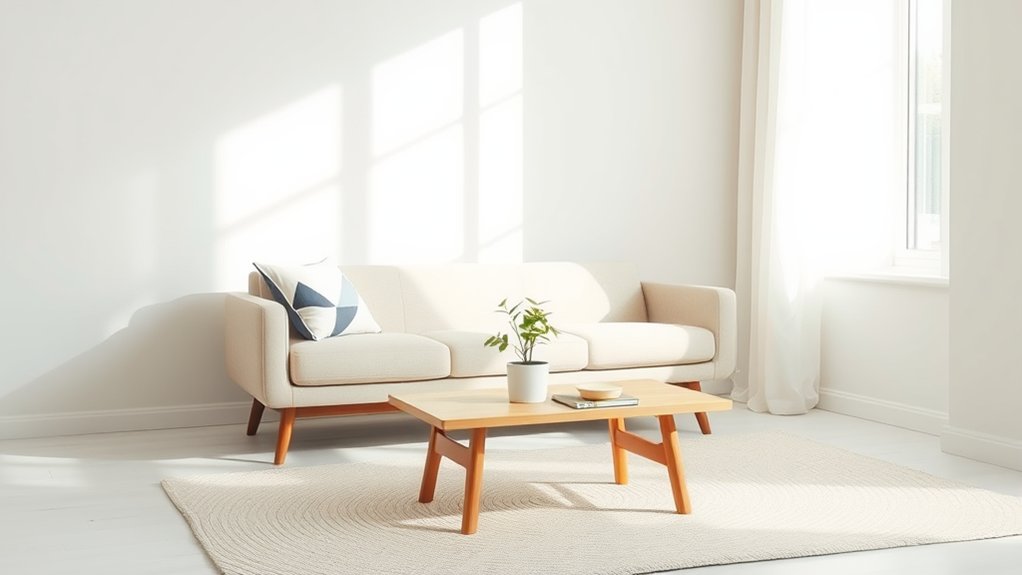
Thoughtful storage solutions not only contribute to an organized living space but also lay the groundwork for achieving a minimalist aesthetic.
To maintain this aesthetic, establishing a regular cleaning schedule is crucial; daily tidying and weekly deep cleaning prevent clutter from accumulating.
Regular decluttering is equally essential—continually editing and curating your belongings helps preserve a clutter-free environment and guarantees only the most meaningful items remain.
Implementing a “one in, one out” policy fosters balance, as removing an item with each new addition maintains order.
Designating a specific spot for every item guarantees organization is upheld, while regular assessments of your space allow you to make necessary adjustments.
These practices collectively sustain a serene, minimalist aesthetic within your living space.
Sustainable Materials for Decor
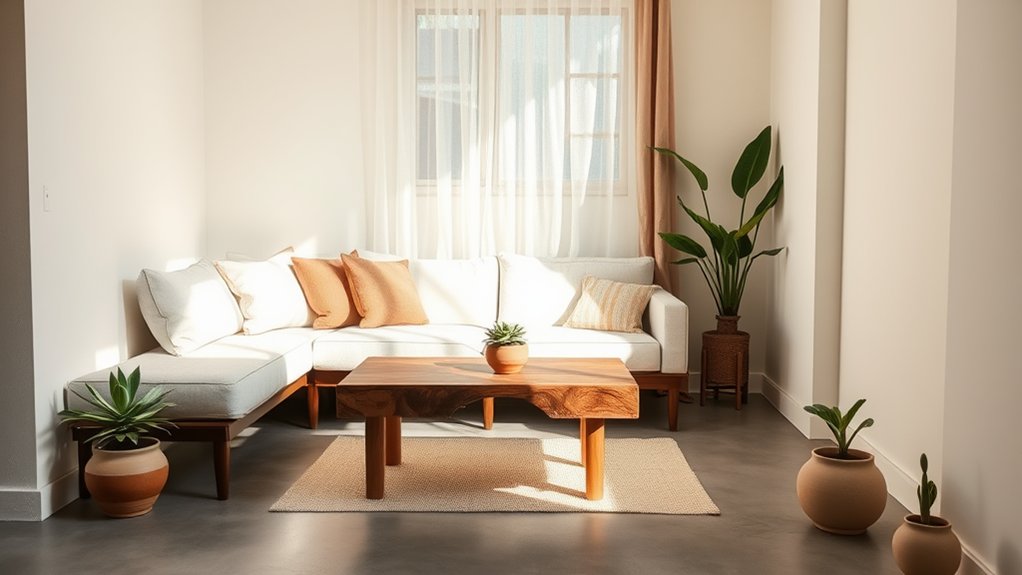
In the domain of small space minimalism, the selection of sustainable materials plays a vital role in creating an eco-friendly aesthetic.
Utilizing natural fiber textiles, such as hemp and jute, not only enhances the design but also supports a commitment to sustainability.
Moreover, incorporating recycled materials into decor reflects a contemporary approach that values both style and environmental responsibility.
Eco-Friendly Material Choices
Sustainability has become an essential principle in the domain of interior design, where eco-friendly material choices substantially enhance the aesthetic and environmental value of small space decor.
Opting for sustainable materials, like bamboo, which possesses a rapid growth cycle, guarantees minimal environmental impact while providing durability.
Recycled plastics, such as polypropylene, offer practical decorative solutions, reducing waste without compromising style.
Moreover, reclaimed wood presents unique character while addressing virgin wood demand.
Incorporating natural materials is vital; biodegradable fibers like hemp and linen excel in upholstery due to their low-water and pesticide requirements.
Ultimately, low-VOC paints promote both indoor air quality and eco-friendliness, aligning perfectly with the minimalist ethos of clean, serene spaces.
Natural Fiber Textiles
Natural fiber textiles have emerged as a cornerstone of minimalist decor, seamlessly blending sustainability with aesthetic appeal. Materials such as hemp, linen, and organic cotton exemplify a minimalist approach that prioritizes ecological responsibility while offering timeless elegance.
Bamboo fiber, known for its renewability, introduces lightweight durability and breathability, enhancing interior comfort. Additionally, jute and sisal add unique textures and earthy tones, creating warmth in minimalist spaces. These versatile textiles can be integrated into rugs, wall hangings, and upholstery, fostering a cohesive, organic look.
Recycled Material Incorporation
Incorporating recycled materials into small space minimalism not only enhances aesthetic appeal but also embodies a commitment to environmental responsibility. Using sustainable elements like recycled plastics, reclaimed wood, and upcycled glass, minimalist decor bridges elegance with eco-consciousness.
These materials can transform ordinary spaces; for instance, old pallets fashioned into coffee tables or vintage windows repurposed as mirrors contribute unique textures and narratives to the room. Additionally, low-VOC paints and bamboo accents can refine the overall ambiance while minimizing indoor air pollutants. Each piece tells its own story, creating a sense of history in your design. By choosing recycled materials, you not only reduce your environmental footprint but also embrace a chic, sustainable lifestyle that signifies modern minimalism.
Trends in Minimalism for 2024
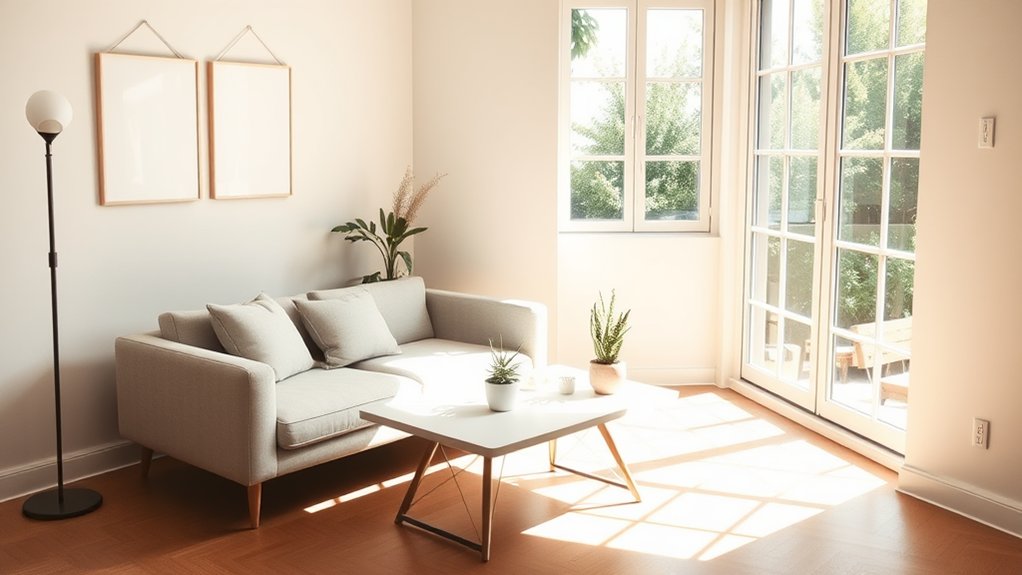
As we venture into 2024, minimalism continues to evolve, embracing fresh trends that enhance functionality and aesthetic appeal in small spaces.
Central to the minimalist lifestyle is the rise of multifunctional furniture, cleverly designed to maximize limited square footage while providing integrated storage solutions.
Sustainability takes precedence, with eco-friendly materials like bamboo, reclaimed wood, and recycled plastics becoming staples in minimalist decor.
Innovative use of novel materials, including glass and acrylic, facilitates designs that visually expand space.
Additionally, smart and natural lighting play vital roles in creating energy-efficient environments.
Emphasizing earthy tones and textures fosters a calm atmosphere, ensuring that minimalism in 2024 reflects both beauty and a harmonious connection to the environment.
Integrating Technology in Design
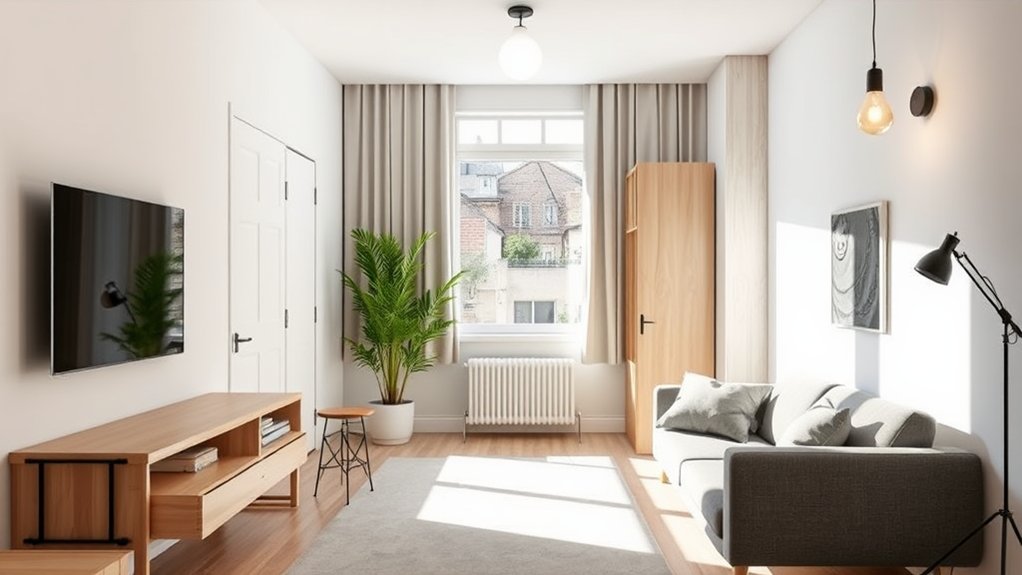
As small space living continues to gain traction, integrating technology becomes essential in achieving both functionality and sustainability.
Smart home solutions, such as automated lighting and space-saving furniture, not only enhance efficiency but also promote a clutter-free environment.
Additionally, the use of sustainable tech materials echoes the minimalist ethos, ensuring that modern design aligns with ecological responsibility.
Smart Home Integration
Utilizing smart home technology within small spaces enhances both functionality and design, allowing minimalist living to thrive without sacrificing modern conveniences. Smart home integration offers innovative solutions that maximize efficiency through automated systems controlling lighting, climate, and security, resulting in a seamlessly curated living environment.
By incorporating these technologies, residents can enjoy the benefits of enhanced convenience and comfort while maintaining a minimalist aesthetic. Features such as voice-activated assistants and app-controlled devices streamline everyday tasks, eliminating the clutter of unnecessary gadgets. Moreover, these integrations often require fewer physical components, adhering closely to minimalism’s principles.
Ultimately, smart home solutions not only elevate the user experience but also reinforce the core tenet of small space living: simplicity without compromise.
Space-Saving Tech Solutions
Incorporating space-saving tech solutions is key to enhancing functionality while maintaining a clean, minimalist design. Smart home devices like thermostats and lighting control systems can be automated and remotely managed to maximize energy efficiency in smaller spaces, ensuring that every square inch of space remains used effectively.
Wireless charging pads and multi-port USB hubs eliminate cord clutter, allowing surfaces to remain clear and streamlined. Moreover, voice-controlled assistants facilitate seamless integration with these systems, minimizing visual clutter within your environment. Lean TV designs and projectors are excellent options for entertainment without sacrificing floor space.
Additionally, automated storage solutions, including motorized drawers hidden within furniture pieces, help to sustain an organized ambiance, reinforcing the principles of small space minimalism.
Sustainable Tech Materials
While the push for minimalism emphasizes simplicity and functionality, integrating sustainable tech materials into design enhances both aesthetic appeal and environmental responsibility. These materials, including recycled plastics and bamboo, serve as key components in creating a minimalist room that is not only visually striking but also eco-conscious.
Energy-harvesting technologies, such as solar-powered windows and kinetic flooring, offer sustainable energy solutions for confined spaces. Furthermore, smart home devices optimize energy efficiency, allowing homeowners to manage their environments remotely. Innovative materials like self-healing concrete and translucent wood are revolutionizing the minimalist design landscape by combining durability with style. Embracing sustainable tech materials is essential for those who seek to balance modern living with a commitment to sustainability.
Creating Flow in Small Rooms

Creating an inviting atmosphere in small rooms hinges on the concept of flow, which revolves around seamless movement and visual harmony. Achieving this involves meticulous planning and intentional design choices.
Start by creating spaces that allow for easy navigation, where furniture placement encourages interaction without obstruction. Opt for multi-functional furniture to reduce excess, effectively keeping the environment free of clutter. Light and airy color palettes can also enhance flow, making the room feel larger and more cohesive. Additionally, consider using mirrors to reflect light and create the illusion of depth, contributing to an open feel.
Curating Quality Decor
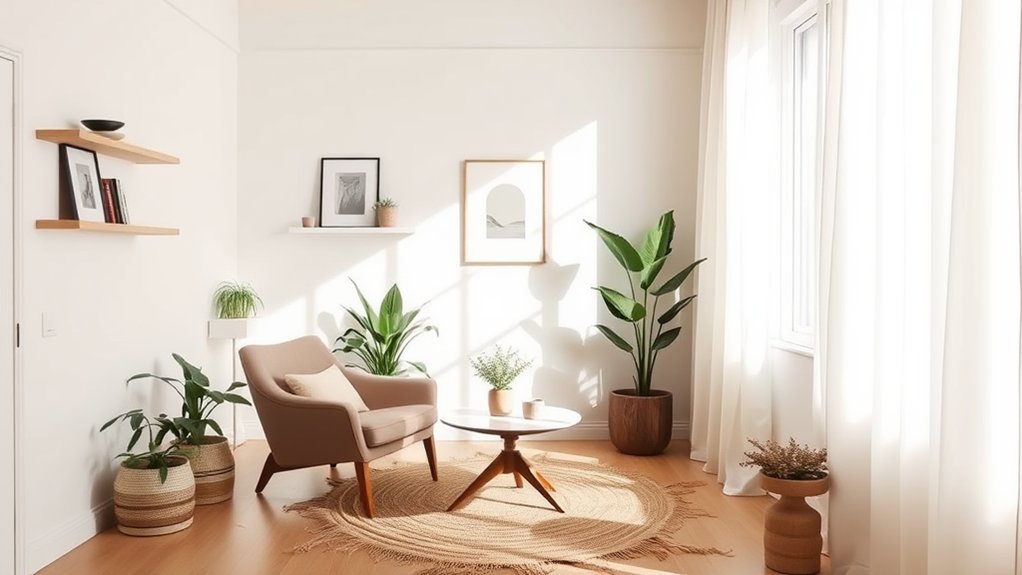
Achieving a harmonious flow in small spaces paves the way for thoughtful decoration that enhances both function and aesthetic appeal.
When curating quality decor, prioritize quality over quantity by selecting a limited number of high-quality pieces that serve a purpose or evoke joy. Opt for decor with simple shapes, clean lines, and a restrained color palette to create a cohesive and uncluttered look. Adhering to the 80/20 rule, choose items that provide the most value or pleasure. Multi-functional pieces, such as a minimalist coffee table that doubles as storage, are essential for maximizing space while minimizing clutter. By favoring natural materials like wood and metal, you can achieve an elegant yet functional environment tailored to small space living.
Natural Elements in Decor
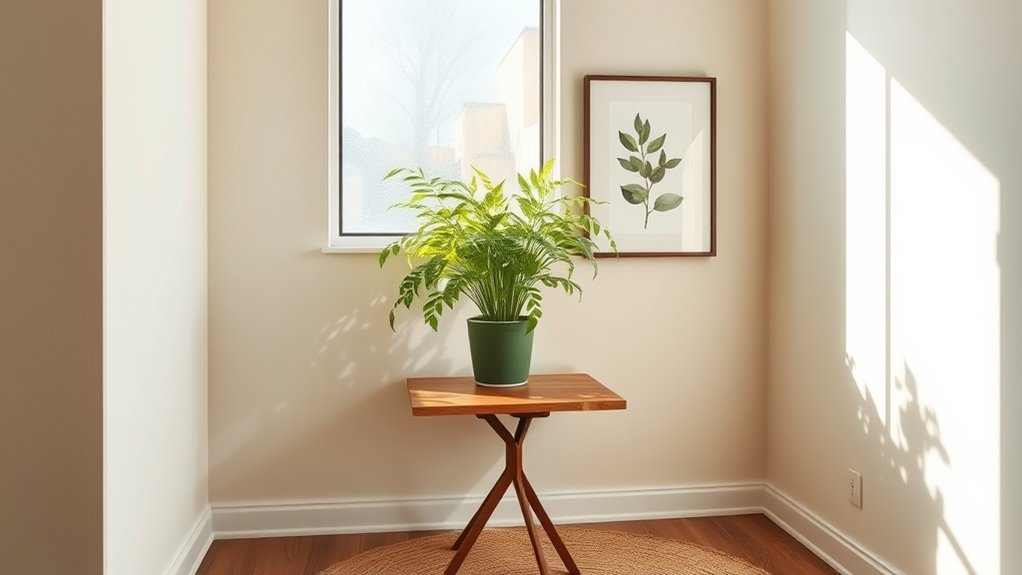
Incorporating wood accents into minimalist decor not only infuses warmth but also establishes a grounding element that echoes nature.
The use of natural textiles, such as jute and wool, enhances the tactile experience of a small space, fostering a harmonious balance between elegance and simplicity.
Together, these elements create a sustainable and serene environment, perfect for modern living.
Incorporating Wood Accents
Wood accents can dramatically enhance the atmosphere of a small minimalist space, infusing it with warmth and a sense of organic elegance. Incorporating wooden elements, such as furniture and wall paneling, fosters a cozy environment while adding visual interest.
Reclaimed or engineered wood offers a sustainable yet stylish choice, appealing to the environmentally conscious. Decorative pieces like wooden bowls or carved sculptures introduce natural textures without overwhelming the design. Light-colored woods, like oak or pine, reflect light, helping the space feel larger, while darker options like walnut add depth.
Using Natural Textiles
Natural textiles play a pivotal role in elevating the aesthetic of small minimalist spaces. Materials like jute, sisal, and seagrass not only infuse warmth and texture but also align with sustainable living practices.
The use of natural fibers, such as linen, cotton, and hemp, is particularly suited for upholstery and window treatments, enhancing both breathability and timeless elegance. Complementing these elements with woven baskets, rattan furniture, and reclaimed wood accents creates an organic sophistication that elevates minimalist decor.
Additionally, incorporating plants housed in wicker or rattan planters enriches the space’s visual appeal while enhancing air quality. Opting for natural textiles in a limited color palette—beige, gray, or taupe—helps maintain a serene and cohesive atmosphere in your minimalist space.
Design Elements to Consider
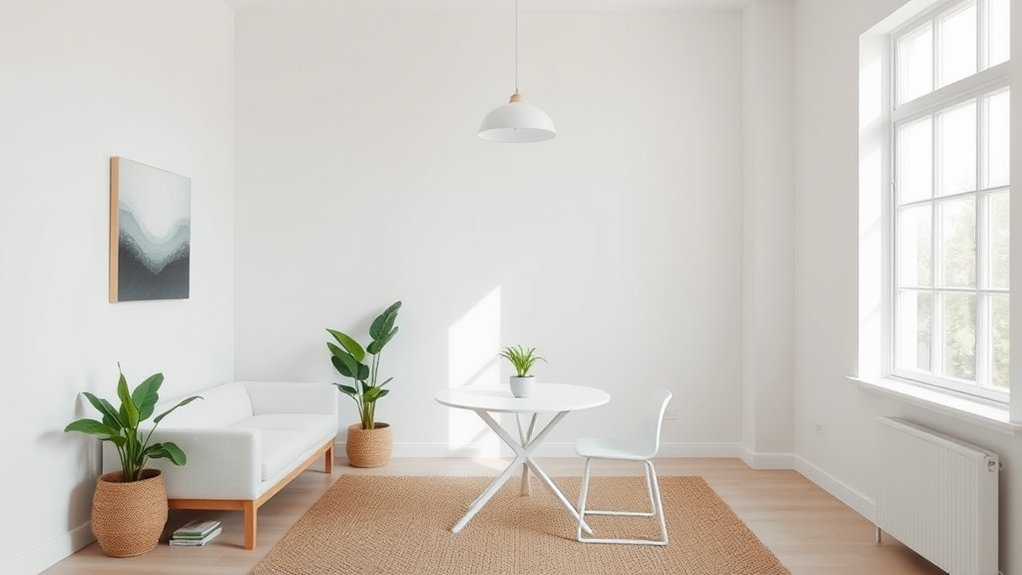
When designing a small space, three key elements deserve careful consideration: color, light, and furniture selection.
The right design elements can transform a small room into a functional and aesthetically pleasing environment.
Start with a cohesive color palette that enhances the room’s dimensions; lighter hues can create an illusion of openness, while strategic pops of color can add personality.
Next, maximize natural and artificial light to guarantee the space feels bright and inviting; mirrors can amplify this effect.
Finally, furniture selection is vital; opt for multi-functional pieces that don’t overwhelm the room.
Lightweight, streamlined designs enable easy rearrangement, maintaining flexibility.
Tips for Small Space Living
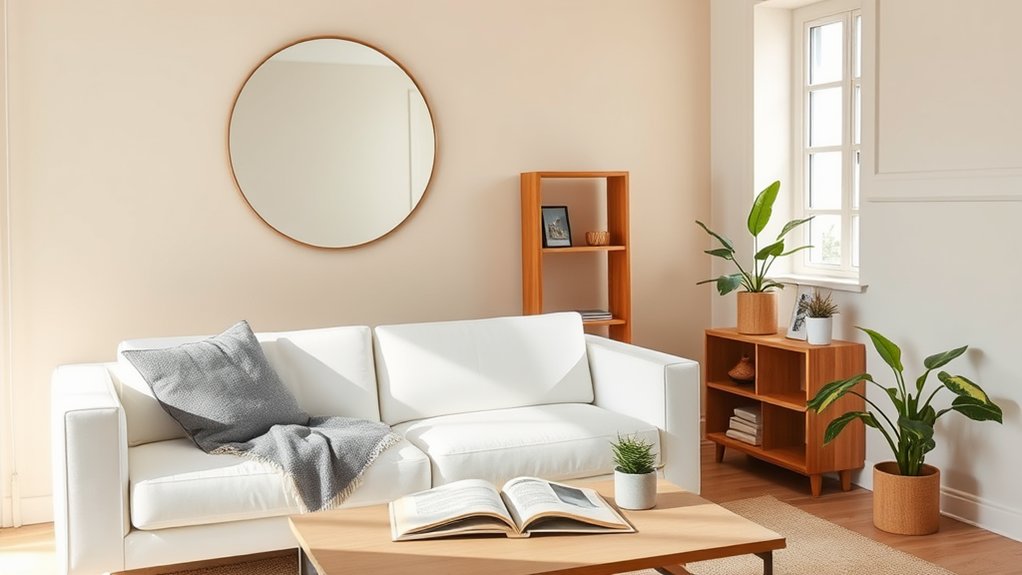
Maximizing functionality in small spaces hinges on the strategic selection of multifunctional furniture and innovative storage solutions.
By incorporating items like sofa beds and coffee tables with built-in storage, residents can optimize their limited square footage while maintaining a stylish aesthetic.
Additionally, smart storage solutions such as wall-mounted organizers can help maintain order and free up valuable floor space, underscoring the principles of small space minimalism.
Multifunctional Furniture Options
In today’s urban landscape, where living spaces are often at a premium, multifunctional furniture emerges as an essential solution for small space living.
Multifunctional furniture pieces, such as sleeper sofas and storage ottomans, offer both seating and sleeping options, maximizing space efficiency. Compact and foldable furniture, including fold-down tables and chairs, can be easily stored, allowing for fluid rearrangements based on needs. Additionally, ottoman beds with hidden storage provide a dual function, serving as both a sleeping area and a discreet spot for clothing.
Smart Storage Solutions
Smart storage solutions are essential for traversing the challenges of small space living. Incorporating multifunctional furniture, such as sleeper sofas and storage ottomans, maximizes space efficiency while providing dual-purpose functionality.
To capitalize on vertical space, install shelves and wall-mounted organizers that keep clutter off the floor and easily accessible. Discover hidden storage opportunities with under-bed bins and cleverly designed closet organizers, fostering a clutter-free environment.
Additionally, opt for compact and foldable furniture to enhance spatial flexibility, enabling swift rearrangement and reducing visual clutter. Implementing a “one in, one out” policy further prevents accumulation, ensuring that each new item earns its place within your home. Prioritize smart storage strategies to maintain a harmonious and organized small living space.
Strategies for Clutter Control
How can one effectively maintain a clutter-free environment in a small space? Implementing robust decluttering strategies is essential for achieving a minimalist aesthetic.
Start with the one-in, one-out rule: for every new item you bring into your home, remove one existing piece to prevent accumulation. Adopt a “home for everything” approach, ensuring each item has a designated spot, thereby enhancing organization and efficiency. Regularly schedule decluttering sessions—perhaps monthly—to reassess belongings and maintain a clean space. Additionally, utilize storage solutions such as baskets, bins, and shelves to keep items neatly organized, promoting a sense of visual calm. By combining these strategies, you can create a tranquil, functional environment that maximizes your smaller living area.
Maximalism Vs Minimalism
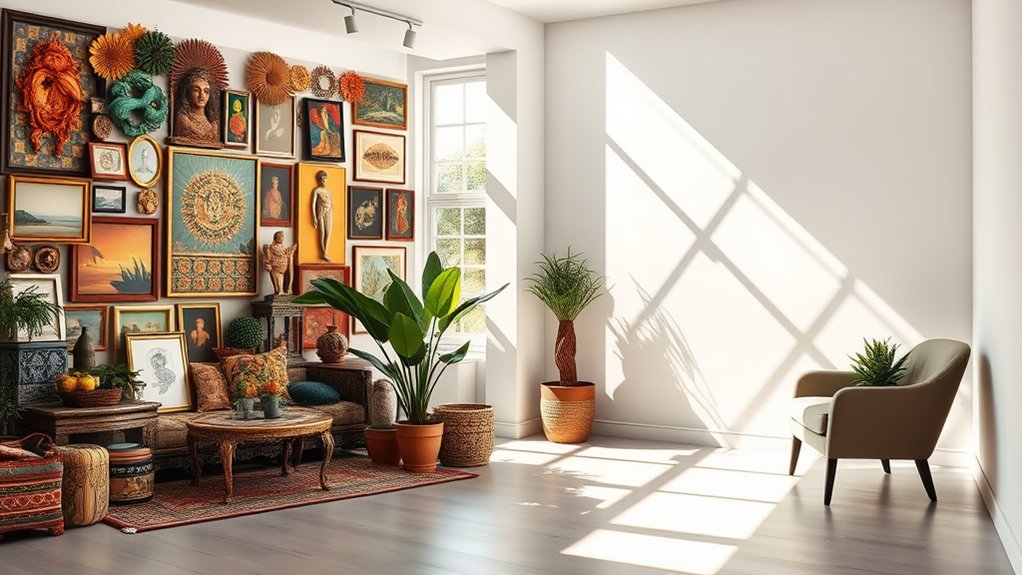
While minimalism champions simplicity and functional design, maximalism embraces the idea that more can indeed be more, celebrating personal expression through abundance and diversity. Minimalism focuses on decluttering and essentialism, effectively utilizing negative space to enhance tranquility and clarity in small areas. In contrast, maximalism invites creativity, layering patterns, colors, and textures that reflect individual personality and emotion.
As trends evolve, a hybrid approach is gaining popularity; “maximalism” often coexists within minimalistic frameworks, allowing pockets of abundance in curated displays.
This fusion illustrates how lifestyle preferences continue to diversify, challenging traditional confines of interior design.
Ultimately, understanding the balance between maximalism and minimalism can help you create a space that truly resonates with who you are.
Assessing Your Space Needs
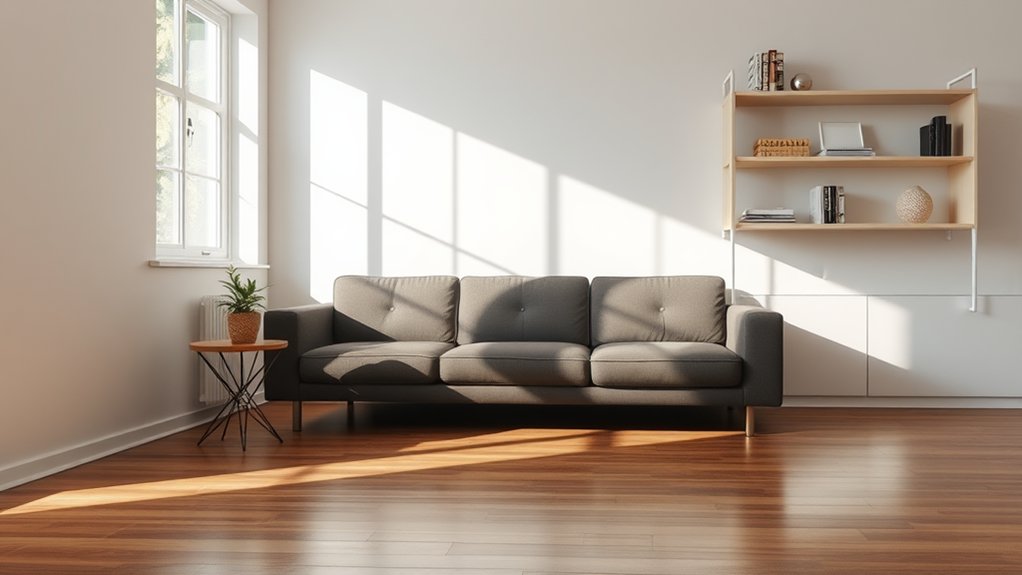
Before diving into the design process, evaluating your space needs is essential for creating a functional environment that aligns with your lifestyle. Begin by measuring your room and listing activities such as working, relaxing, or entertaining.
Consider how many individuals will use the space and what type of furniture and storage solutions are necessary for their comfort. Conduct an inventory of your belongings, categorizing them into essentials, non-essentials, and items to discard, which clarifies your storage requirements.
Reflect on your lifestyle; if you work from home or have hobbies requiring dedicated space, identify these priorities. Finally, consider natural light, ventilation, and noise levels, as optimizing these factors contributes substantially to a cozy and effective living area.
Personalizing Minimalist Interiors
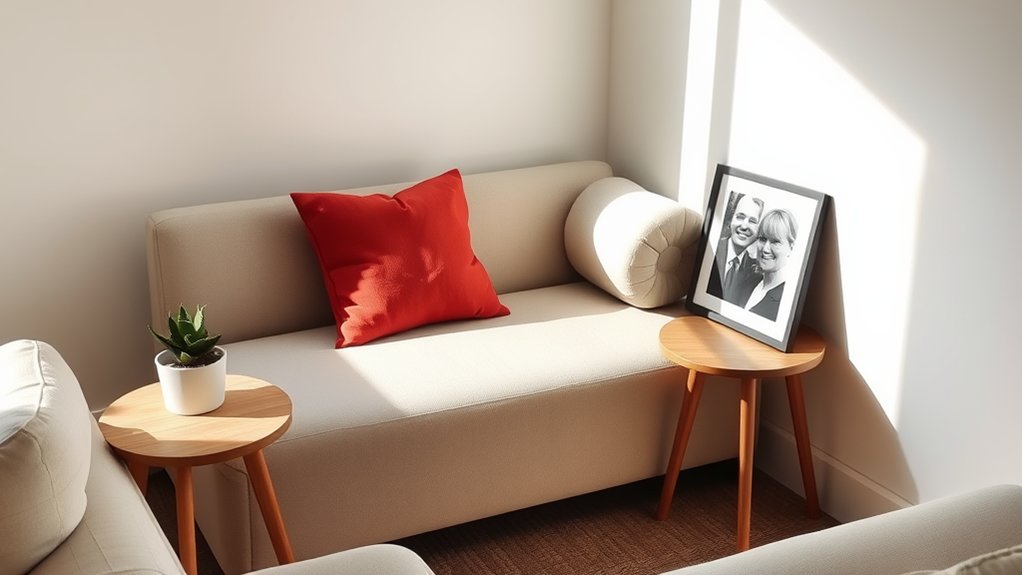
Personalizing minimalist interiors is an art that involves thoughtfully integrating unique decorative elements to reflect individuality without compromising the core principles of simplicity.
To achieve this balance, it’s key to select meaningful items such as artwork or sentimental objects that add personality while enhancing the overall aesthetic. Incorporating personal elements, like family photos or heirlooms, can introduce warmth and character, making the space feel lived-in and inviting.
Utilizing color, texture, and pattern in a restrained manner can further enrich a minimalist environment, creating visual interest without overwhelming it. Adopting a “one in, one out” policy guarantees that any new decorative elements uphold the ethos of minimalism, maintaining a clutter-free and intentional ambiance in your home.
Connections Between Minimalism and Well-Being
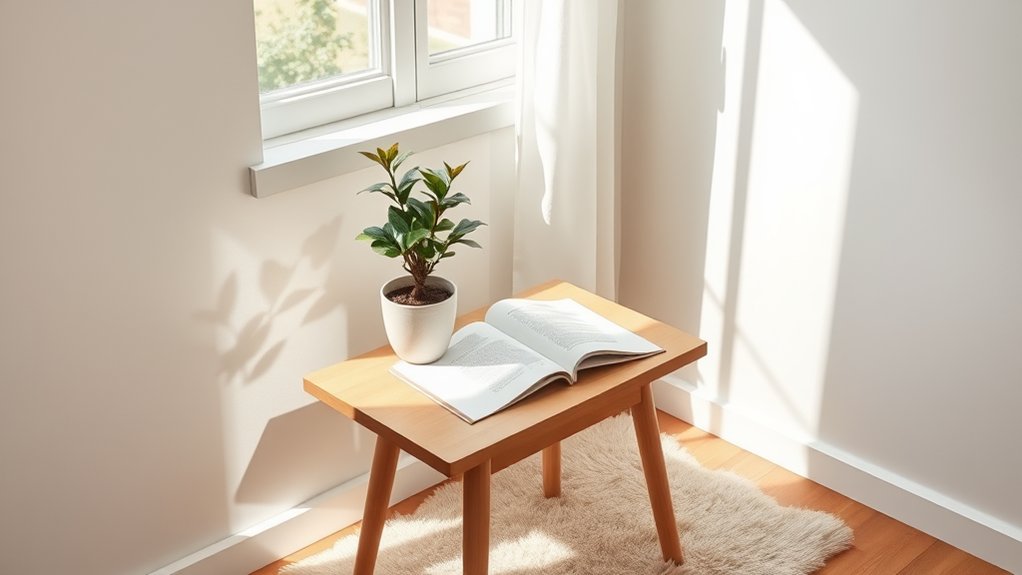
Numerous studies indicate that minimalist living environments can substantially enhance well-being by fostering calmness and reducing stress. The link between a minimalist lifestyle and mental health stems from the detrimental effects of clutter, which often induces visual stress and distraction.
In contrast, minimalist spaces promote relaxation and improved focus, contributing to lower cortisol levels and better mental health outcomes. Individuals residing in decluttered, simplified environments report enhanced productivity, time management, and a profound sense of control over their surroundings.
Real-World Minimalist Examples

While many individuals are discovering the benefits of minimalism, real-world examples illustrate how this lifestyle can be practically applied in various contexts.
The Japanese concept of “wabi-sabi” epitomizes minimalist design, celebrating simplicity, imperfection, and natural materials, especially in small spaces. The tiny house movement showcases efficient living with minimal clutter and design, while Scandinavian interiors employ light colors and natural textures to enhance openness. Urban dwellers increasingly opt for micro-apartments that prioritize multifunctional furniture and sparse decor, effectively maximizing space.
Moreover, renowned architect Tadao Ando‘s work highlights minimalist architecture, using simple geometric forms and focusing on natural light to evoke tranquility. These examples reflect how minimalist living can transform small spaces into serene, functional environments.
Challenges of Minimalist Living
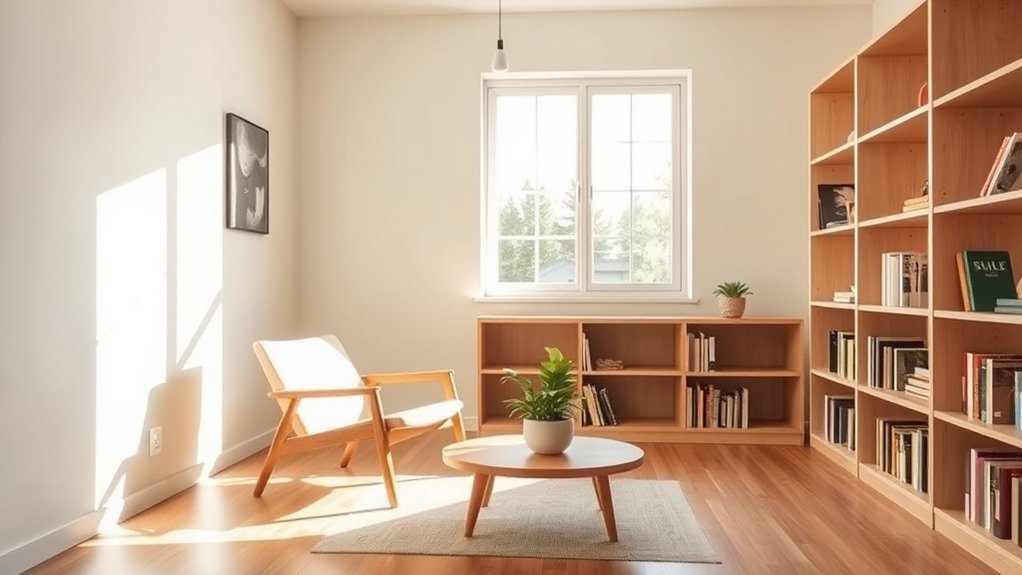
Embracing minimalism in small spaces often comes with its own set of challenges that require thoughtful consideration and discipline.
The minimalist lifestyle necessitates careful planning and editing of belongings to sustain a clutter-free environment.
One significant hurdle is the discipline needed to resist accumulating new possessions, coupled with the commitment to regularly declutter.
Additionally, crafting functional zones within limited square footage demands intentional furniture selection and creative storage solutions.
Multi-functional furniture and innovative room dividers emerge as essential tools to maximize usability.
With even minor clutter having a pronounced visual impact, maintaining a minimalist aesthetic becomes vital, underscoring the need for consistent cleaning and organization.
These elements highlight the complexities inherent in small space minimalism.
Future of Minimalist Design
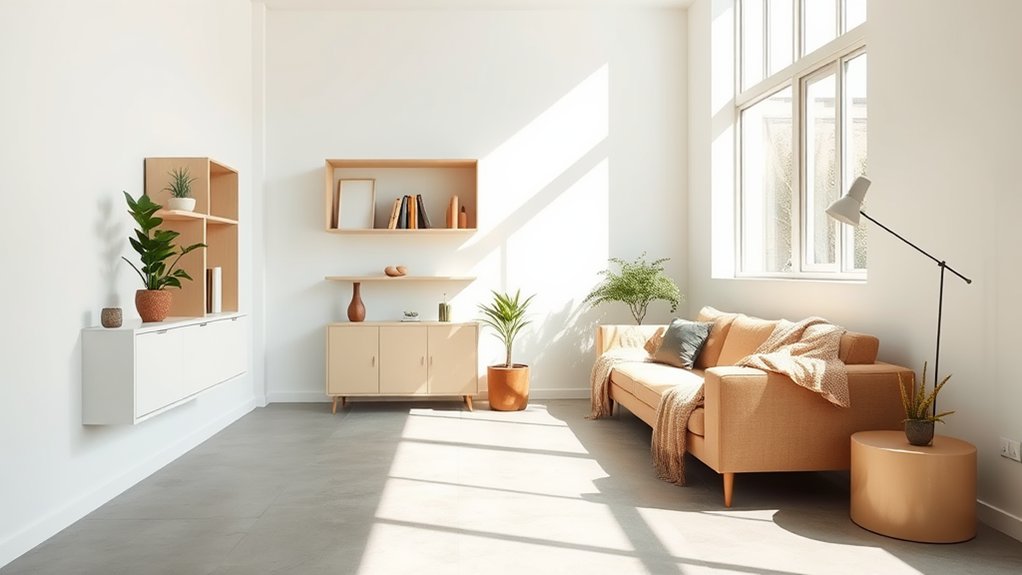
The future of minimalist design is poised to evolve toward greater sustainability and innovation, reflecting a growing consciousness about environmental impact. As the minimalist lifestyle gains popularity, more designers will integrate eco-friendly materials like recycled plastics and bamboo into their creations.
Multifunctional furniture will dominate the market, allowing spaces to adapt seamlessly to various needs, maximizing utility in small environments.
Additionally, advancements in technology will introduce features such as built-in wireless charging and smart lighting, enhancing both convenience and functionality.
The use of translucent materials like glass will foster an airy atmosphere, expanding visual space in compact areas.
Innovations like 3D printing and modular construction will also redefine furniture design, offering exciting possibilities for personalized, efficient living.
Frequently Asked Questions
How Can I Start Embracing Minimalism in My Daily Life?
To embrace minimalism in daily life, focus on simple routines that prioritize essential items. Develop daily habits that reduce clutter, such as decluttering regularly, limiting purchases, and embracing multifunctional spaces, enhancing both functionality and serenity.
What Are Common Misconceptions About Minimalist Living?
Common misconceptions about minimalist living often paint a stark, empty canvas. In reality, minimalist myths can cloud the essence of simple living, which embraces intentionality and joy in curated possessions rather than deprivation or restrictive living.
How Do I Handle Sentimental Items in a Minimalist Space?
Handling sentimental items in a minimalist space requires a delicate balance between emotional attachment and practicality. Begin by evaluating each item’s sentimental value and consider preserving memories through digital formats or creative displays to retain significance while minimizing physical clutter.
Can Minimalism Be Applied in Different Cultural Contexts?
Yes, minimalism can indeed be adapted across diverse cultural contexts. Cultural minimalism reflects local social norms, values, and aesthetics, allowing individuals to embrace minimalism while honoring their heritage and identity, fostering a personalized approach to simplicity.
How Do I Maintain a Minimalist Lifestyle With Children or Pets?
Research indicates that 60% of households with kids or pets report significant challenges in maintaining organization. To combat kid clutter and enhance pet organization, establish designated spaces, utilize multifunctional furniture, and encourage involvement from all family members.
Conclusion
To summarize, embracing small space minimalism offers a profound transformation in both living environments and psychological well-being. As the theory suggests, decluttering not only enhances physical spaces but also fosters clarity and tranquility of mind, reinforcing the symbiotic relationship between environment and mental health. The ongoing trend towards minimalist design reflects a collective shift towards sustainability and intentional living, signifying that simplicity is not merely an aesthetic choice, but a lifestyle imbued with purpose and mindfulness.

